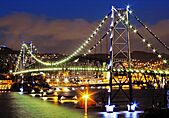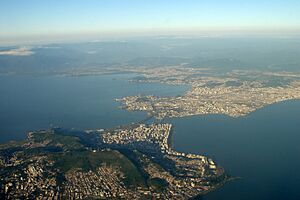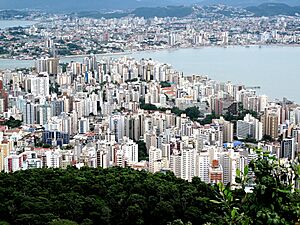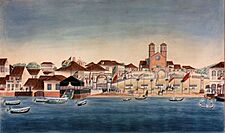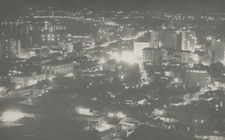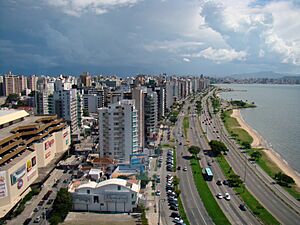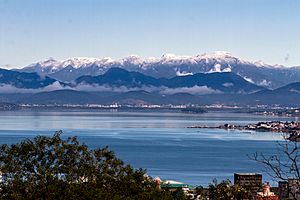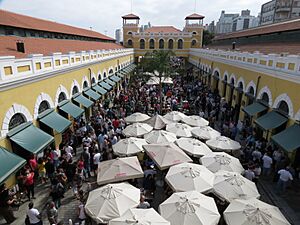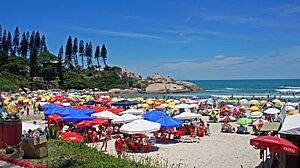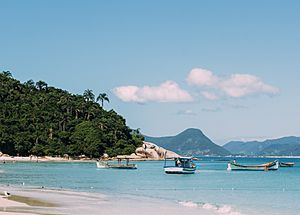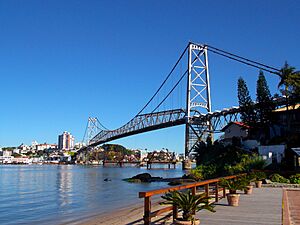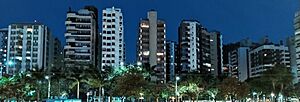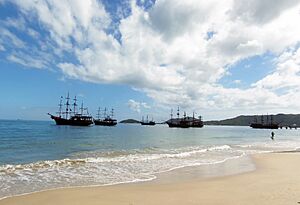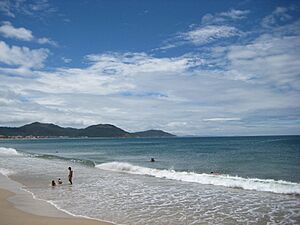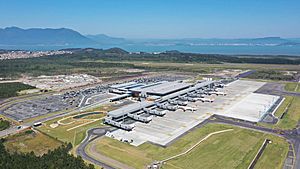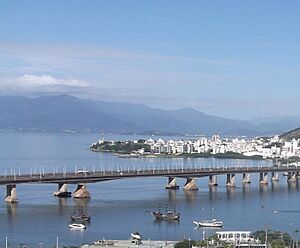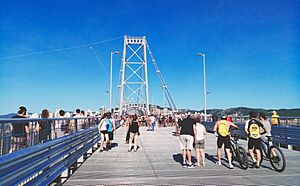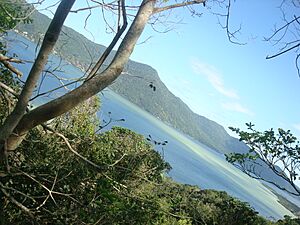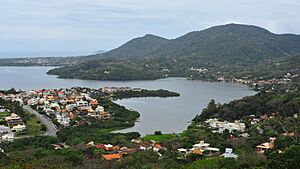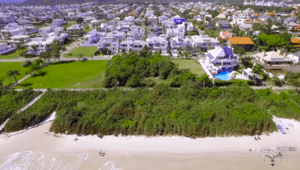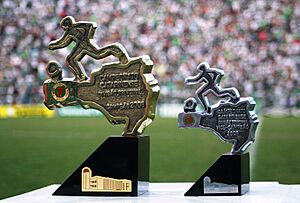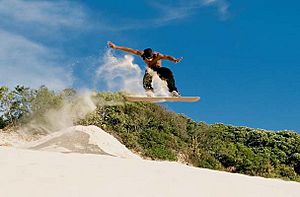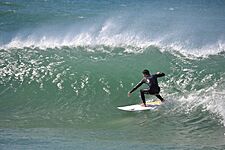Florianópolis facts for kids
Quick facts for kids
Florianópolis
|
|||
|---|---|---|---|
| Município de Florianópolis Municipality of Florianópolis |
|||
|
From top to bottom and left to right: panorama of central region from Morro da Cruz; Hercílio Luz Bridge at night; Florianópolis Cathedral; Beira Mar Avenue; Public Market; Joaquina Beach; Fortress of São José da Ponta Grossa.
|
|||
|
|||
| Nicknames:
Floripa, Magic Island
|
|||
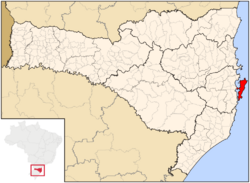 |
|||
| Country | |||
| Region | South | ||
| State | |||
| Founded | March 23, 1623 | ||
| Named for | Floriano Peixoto | ||
| Area | |||
| • Municipality | 675.409 km2 (260.777 sq mi) | ||
| Elevation | 3 m (9 ft) | ||
| Population
(2022)
|
|||
| • Municipality | 537,211 | ||
| • Density | 795.3862/km2 (2,060.041/sq mi) | ||
| • Urban | 358,180 | ||
| • Metro | 1,111,702 | ||
| Demonym(s) | Florianopolitano Manezinho (colloquial) |
||
| GDP (PPP, constant 2015 values) | |||
| • Year | 2023 | ||
| • Total | $19.3 billion | ||
| Time zone | UTC-3 (UTC-3) | ||
| Postal Code |
88000-000 to 88099-999
|
||
| Area code(s) | (+55) 48 | ||
| HDI (2010) | 0.847 – very high | ||
Florianópolis is the capital city of the state of Santa Catarina in the South region of Brazil. It is the second largest city in the state. The city includes Santa Catarina Island, many smaller islands, and part of the mainland. In 2022, about 537,211 people lived here. This makes it the 39th most populated city in Brazil. The larger metropolitan area has over 1.1 million people. Florianópolis is known for having a very high Human Development Index, which means people generally have a good quality of life.
The city's economy mainly relies on information technology, tourism, and services. Florianópolis has 60 beaches and is a popular spot for surfing. Lagoa da Conceição is a famous area for tourists, fun activities, nature, and exciting sports. The New York Times called Florianópolis a top "Party Destination" in 2009. Newsweek also listed it as one of the "ten Most Dynamic cities of the World" in 2006. Because of this, many people from other parts of Brazil and countries like Argentina, Uruguay, the U.S., and Europe are buying vacation homes here.
Florianópolis is often called Floripa or Ilha da Magia (Magic Island). Most people live on the mainland and the central or northern parts of the island. The southern part is less populated. Many small-scale fishermen live on the island. Their fishing boats, the lacemakers, local stories, food, and old colonial architecture help bring in tourists. These visitors help the city's economy, as there isn't much large industry. Villages like Santo Antônio de Lisboa and Ribeirão da Ilha still keep their old traditions and history.
The Hercílio Luz International Airport serves the city. Florianópolis is also home to important schools like the Universidade Federal de Santa Catarina (Federal University of Santa Catarina). There are also the Santa Catarina Federal Institute of Education, Science and Technology and two campuses of the Universidade do Estado de Santa Catarina (State University of Santa Catarina).
Contents
- What's in a Name?
- Discovering Florianópolis's Nature
- Florianópolis: A Look at Its Past
- Who Lives in Florianópolis?
- Florianópolis's Economy
- Learning in Florianópolis
- Fun and Life in Florianópolis
- Parts of the City
- Getting Around Florianópolis
- Neighborhoods of Florianópolis
- Sports in Florianópolis
- Famous People from Florianópolis
- Sister Cities
- Images for kids
- See also
What's in a Name?
The name Florianópolis honors Marshal Floriano Peixoto. He was the second President of Brazil from 1891 to 1894. The name also comes from the Greek word polis, which means "city". Before 1893, the city was called Nossa Senhora do Desterro or simply Desterro. This means "Our Lady of Banishment".
Discovering Florianópolis's Nature
What Plants Grow Here?
Florianópolis is part of the Atlantic Forest. This forest has many different types of plants and trees. The main type is the coastal Atlantic forest. This forest is a narrow strip along the coast, about 50 to 100 kilometers (31 to 62 miles) wide. It can reach up to 2,000 meters (6,560 feet) above sea level. Different heights create different plant types. There are lowland forests near the coast, mountain forests, and high-altitude grasslands.
The city also has important nature reserves. Part of the 17,104-hectare (42,265-acre) Marinha do Arvoredo Biological Reserve is here. This reserve protects marine life. Also, part of the 84,130-hectare (207,890-acre) Serra do Tabuleiro State Park is in the municipality. This park has lush forests and protects the sources of rivers that provide drinking water for the area. The 1,532-hectare (3,786-acre) Rio Vermelho State Park is in the northeast of Santa Catarina Island. It was created in 2007.
How Much Rain Does Florianópolis Get?
Florianópolis gets a lot of rain throughout the year. The average yearly rainfall is about 1,517.8 millimeters (59.76 inches). There is no dry season. Summer usually has the most rain, with about 160 millimeters (6.3 inches) per month from January to March. From April to December, there is less rain, averaging about 100 millimeters (3.9 inches) per month. The driest months are June to August.
What is the Weather Like?
Florianópolis has a warm humid subtropical climate. This means it has clear seasons. Summer and winter are well-defined, and autumn and spring have their own typical weather. Because it's close to the sea, the air is usually humid, around 80%.
The area faces challenges from climate change. Rising sea levels are expected to cause more coastal erosion. To help with this, Mangroves are being planted around the city. This helps protect the coast and restore local ecosystems.
In the hottest month, temperatures can range from 25 to 38.8 °C (77 to 101.8 °F). In the coldest month, temperatures can be from 6 to 11 °C (43 to 52 °F). The lowest temperature ever recorded was -0.4 °C (31.3 °F) in July 2000. The highest was 38.8 °C (101.8 °F) in February 1973.
| Climate data for Florianópolis (1991–2020 normals, extremes 1961–present)) | |||||||||||||
|---|---|---|---|---|---|---|---|---|---|---|---|---|---|
| Month | Jan | Feb | Mar | Apr | May | Jun | Jul | Aug | Sep | Oct | Nov | Dec | Year |
| Record high °C (°F) | 40.0 (104.0) |
38.8 (101.8) |
36.9 (98.4) |
35.4 (95.7) |
33.5 (92.3) |
32.0 (89.6) |
32.7 (90.9) |
35.0 (95.0) |
32.9 (91.2) |
35.4 (95.7) |
34.8 (94.6) |
38.6 (101.5) |
40.0 (104.0) |
| Mean daily maximum °C (°F) | 29.4 (84.9) |
29.5 (85.1) |
28.7 (83.7) |
26.9 (80.4) |
24.0 (75.2) |
21.9 (71.4) |
21.1 (70.0) |
21.8 (71.2) |
22.4 (72.3) |
24.2 (75.6) |
26.1 (79.0) |
28.3 (82.9) |
25.4 (77.6) |
| Daily mean °C (°F) | 25.2 (77.4) |
25.3 (77.5) |
24.4 (75.9) |
22.4 (72.3) |
19.5 (67.1) |
17.2 (63.0) |
16.5 (61.7) |
17.4 (63.3) |
18.7 (65.7) |
20.6 (69.1) |
22.3 (72.1) |
24.2 (75.6) |
21.1 (70.1) |
| Mean daily minimum °C (°F) | 21.6 (70.9) |
21.7 (71.1) |
20.7 (69.3) |
18.7 (65.7) |
15.7 (60.3) |
13.6 (56.5) |
12.9 (55.2) |
13.8 (56.8) |
15.4 (59.7) |
17.5 (63.5) |
18.8 (65.8) |
20.5 (68.9) |
17.6 (63.6) |
| Record low °C (°F) | 14.6 (58.3) |
14.8 (58.6) |
10.2 (50.4) |
7.7 (45.9) |
3.3 (37.9) |
1.7 (35.1) |
−0.4 (31.3) |
0.9 (33.6) |
0.7 (33.3) |
8.2 (46.8) |
9.4 (48.9) |
12.5 (54.5) |
−0.4 (31.3) |
| Average precipitation mm (inches) | 241.3 (9.50) |
198.3 (7.81) |
180.4 (7.10) |
115.8 (4.56) |
126.2 (4.97) |
86.3 (3.40) |
100.8 (3.97) |
93.0 (3.66) |
146.9 (5.78) |
153.2 (6.03) |
146.6 (5.77) |
177.2 (6.98) |
1,766 (69.53) |
| Average precipitation days (≥ 1.0 mm) | 16 | 15 | 14 | 9 | 9 | 7 | 9 | 7 | 11 | 13 | 13 | 12 | 135 |
| Average relative humidity (%) | 79.0 | 79.4 | 79.2 | 79.7 | 80.7 | 81.9 | 82.4 | 80.7 | 80.0 | 80.0 | 77.4 | 77.9 | 79.9 |
| Average dew point °C (°F) | 21.8 (71.2) |
21.9 (71.4) |
21.1 (70.0) |
19.2 (66.6) |
16.6 (61.9) |
14.6 (58.3) |
13.9 (57.0) |
14.4 (57.9) |
15.4 (59.7) |
17.4 (63.3) |
18.5 (65.3) |
20.4 (68.7) |
17.9 (64.3) |
| Mean monthly sunshine hours | 190.7 | 174.0 | 186.7 | 179.5 | 173.4 | 153.0 | 162.2 | 166.7 | 141.3 | 142.7 | 180.5 | 191.2 | 2,041.9 |
| Mean daily daylight hours | 13.6 | 13.0 | 12.2 | 11.4 | 10.8 | 10.4 | 10.6 | 11.2 | 12.0 | 12.8 | 13.5 | 13.9 | 12.1 |
| Average ultraviolet index | 12 | 12 | 11 | 8 | 5 | 4 | 4 | 6 | 8 | 10 | 12 | 12 | 9 |
| Source 1: Instituto Nacional de Meteorologia | |||||||||||||
| Source 2: Meteo Climat (record highs and lows) | |||||||||||||
Florianópolis: A Look at Its Past
The first people to live in the Florianópolis area were the Carijós Indians. They were a Tupi people. We know they were here from old archaeological sites and shell mounds called sambaquis. These date back up to 4,000 years ago. The Indians called the place Meiembipe, meaning "mountain along the channel".
Around 1514, the Portuguese arrived. They first named the area Ilha dos Patos. In 1526, it was renamed Ilha de Santa Catarina (Saint Catherine's Island). This area was important for ships traveling to the River Plate Basin.
The island officially began to be settled in 1673. This happened when Francisco Dias Velho's farming company arrived. In 1678, a chapel was built for Nossa Senhora do Desterro. A small village slowly started to grow around it.
To keep control of the area, the Portuguese Crown made Santa Catarina Island a village in 1714. It was called Nossa Senhora do Desterro. In 1726, it became a town.
From then on, Vila do Desterro and its port became very important. It was located halfway between Rio de Janeiro and Buenos Aires. These were two of the biggest seaside cities in South America at the time. Because of this, the Capitania da Ilha de Santa Catarina was created in 1739. Desterro became its capital. Soon, strong defenses were built. These included the Santa Cruz, São José da Ponta Grossa, Santo Antonio, and Nossa Senhora da Conceição da Barra do Sul fortresses.
The population grew with the new Captaincy. A big population boom happened between 1747 and 1756. About 6,000 settlers arrived from the Azores and Madeira Island. Farming, cotton and linen industries, and trade grew with these Azorean settlers.
In 1823, during the time of the monarchy, Desterro became the Capital of Santa Catarina Province. This brought a time of growth with many new buildings and strong political groups.
Later, some local leaders were unhappy with the government. They started the Federalist Revolution. This movement began in Rio Grande do Sul and spread to Santa Catarina. Desterro became the Federalist Capital of the Republic. The president of Brazil at the time, Marshal Floriano Peixoto, stopped the rebellion. He ordered many people he saw as enemies to be shot at the Anhatomirim Island Fortress. To show loyalty to the marshal, the capital's name was changed in 1893. It went from Desterro to Florianópolis, meaning "city of Floriano".
Who Lives in Florianópolis?
| Race and ethnicity in Florianópolis | ||||
|---|---|---|---|---|
| Ethnicity | Percentage | |||
| White | 76.4% | |||
| Pardo (Multiracial) | 16.3% | |||
| Black | 6.7% | |||
| Asian | 0.4% | |||
| Amerindian | 0.2% | |||
Religion in Florianópolis (2010) Catholic Church (63.68%) Protestantism (12.81%) Spiritism (7.48%) Other religions (4.05%) Irreligious (11.76%)
| Historical population | ||
|---|---|---|
| Year | Pop. | ±% |
| 1970 | 138,337 | — |
| 1980 | 187,880 | +35.8% |
| 1991 | 255,390 | +35.9% |
| 2000 | 342,315 | +34.0% |
| 2010 | 421,240 | +23.1% |
| 2022 | 537,211 | +27.5% |
| Source: | ||
In 2022, the city had 537,211 people. The population density was about 623.68 people per square kilometer. Most people in Florianópolis are of European descent. Many Portuguese colonists from the Azores Islands arrived in the mid-1700s. The population is mainly made up of people with Portuguese/Azorean, German, and Italian backgrounds.
Some neighborhoods in the south still feel like old rural villages. The culture from their Azorean ancestors can be seen in their way of speaking, their crafts, and their traditional celebrations.
The small village of Santo António de Lisboa shows colonial architecture. In Ribeirão da Ilha, the oldest part of the capital, people speak with an accent similar to the original Azorean settlers. The church of Our Lady of Lapa do Ribeirão, built in 1806, is in Ribeirão da Ilha. Lagoa da Conceição also keeps many signs of its colonial architecture. It has sand dunes, restaurants, nightlife, and women who make lace to sell.
Most of Florianópolis's residents, about 96.2%, live in the urban area. Only 3.78% live in the rural area. The city has become more diverse as people from other Brazilian states and foreigners have moved there. The island, once a whale hunting center, is now a hub for the IT industry.
Religious Beliefs
According to the 2010 Brazilian Census, most people in Florianópolis are Roman Catholic (63.68%). Other groups include Protestants and evangelicals (12.81%) and Spiritists (7.48%). About 11.76% of people said they had no religion.
Florianópolis's Economy
In 2002, farming made up a very small part of the economy (0.05%). Manufacturing was 3.41%, and the commerce and service sector was the largest at 96.54%.
Tourism is a major part of Florianópolis's economy. This is because of its Azorean culture and its coastal location. The city has rules to protect its environment and limit building. This helps keep its original charm.
The city has invested a lot in things like roads and schools. Florianópolis scores high in areas like literacy (97%) and electrification (almost 100%). By the late 1990s, many private companies were moving to the island. Some even started from a technology "incubator" at the federal university. One invention from there was the computerized voting machines used in Brazilian elections. Local officials now want Florianópolis to be known as the "Silicon Valley of Brazil," but with beaches!
Besides its beautiful beaches, Florianópolis has many historical places. These include sites from the original Azorean settlers, the Lagoa da Conceição lagoon, and Santo Antônio de Lisboa. Tourism has grown a lot in the last 10 years. More visitors come from other big cities in Brazil and from other South American countries like Argentina.
Technology and software companies have also grown quickly. Today, Information Technology services bring in a lot of money for Florianópolis. There are several technology centers around the city, making it an important place for this industry.
The total value of goods and services produced in the city (the GDP) was R$323.264 billion in 2019. The average income per person in the city was R$45,602 in 2021.
Learning in Florianópolis
Universities and Colleges
Florianópolis has many places for higher education:
- Universidade Federal de Santa Catarina (UFSC);
- Universidade do Estado de Santa Catarina (UDESC);
- Serviço Nacional de Aprendizagem Comercial (Senac/SC);
- Complexo de Ensino Superior de Santa Catarina (CESUSC);
- Universidade do Sul de Santa Catarina (UNISUL);
- Universidade do Vale do Itajaí (UNIVALI);
- Centro Universitário Estácio de Sá de Santa Catarina;
- Instituto Federal de Educação, Ciência e Tecnologia de Santa Catarina (IFSC);
- and many others.
Top High Schools
Some of the best high schools in Florianópolis, based on the 2007 National High School Exam (Exame Nacional do Ensino Médio), include: Escola Autonomia, Colégio da Lagoa, Colégio Energia, Colégio Tendência, Colégio Expoente, Colégio Adventista de Florianópolis, Colégio Geração, Colégio de Aplicação UFSC, EEB Feliciano Nunes Pires, IFSC, Colégio Decisão, EEB Professor AníbalNunes Pires, Instituto Estadual de Educação, EEB Osmar Cunha, EEb Getúlio Vargas, EEB Presidente Roosevelt, EEB Professor Henrique Stodieck.
Fun and Life in Florianópolis
Florianópolis is one of Brazil's most visited places. It's an island with 42 beaches, lagoons, and waterfalls.
Amazing Beaches to Explore
Lagoa da Conceição
Conceição Lagoon (Lagoa da Conceição) is the biggest lagoon on Santa Catarina Island. It's very popular with tourists and backpackers. The area around the lagoon has many restaurants, bars, markets, and shops. Many people from other countries and Brazilian cities choose to live here. They love the views, safety, nature, and good quality of life.
The lagoon is surrounded by mountains and has a canal that connects to the ocean. The history of the area around the lagoon is rich with local stories, fishing traditions, old Portuguese buildings, and an 18th-century church on a hill.
The Holy Spirit Feast (Festa do Divino) is a festival held 40 days after Easter. This celebration dates back to colonial times. It includes a parade, music, and street food.
Mole Beach
Mole Beach (Praia Mole) is a well-known beach near Conceição Lagoon. It's famous for its green hills and rock formations on both sides. This beach is great for surfing, and it has eco-friendly lounges. It's also a popular spot for the LGBTQ community in summer. The beach hosts a stop on the ASP World Tour for professional surfers. Santa Catarina is the only place in South America for this surfing event. The Santa Catarina Art Museum is also in the city.
Joaquina Beach
Joaquina Beach (Praia da Joaquina) became famous in the 1970s. Surfers from all over the world discovered its amazing waves. You can reach Joaquina Beach from the Lagoon of Conceição. Many surf competitions started here, and great surfers from Santa Catarina emerged. It has good facilities for tourists. Many visitors from Brazil and other countries come here in spring and summer. The rocks on the left side, night lighting, and public showers are special features. There's a large paid parking lot, restrooms, and places to rent sandboards.
Barra da Lagoa
Barra da Lagoa is a charming fishing village. The beach is perfect for learning to surf. It's a cove on the eastern part of the island and stretches for 15 kilometers (9.3 miles) into Moçambique beach. It's a natural area with no huge hotels. The Southern headquarters of Projeto TAMAR (Save the Turtles) is located here. Penguins sometimes swim into the canal and near the beach in winter (June, July, August). The canal at Barra da Lagoa connects the Lagoa da Conceição to the open sea. You can often see fishermen at night catching shrimp to sell to local restaurants.
Ingleses Beach
Ingleses Beach (Praia dos Ingleses) is a favorite for tourists. But it still keeps the traditions of its Azorian settlers. In summer, it's a top beach for Argentine tourists, second only to Canasveiras. In winter, you can see mullet fishing, religious events, and local festivals. The sand dunes between Ingleses Beach and Santinho Beach are a main attraction. Sandboarding is very popular here, and you can rent boards. You can also hike 4 kilometers (2.5 miles) over the dunes for a different adventure.
Armação Beach
Armação Beach (Praia da Armação) has a rich history. The Sant'Anna Church, built by a fishing company, is part of it. Whale hunters and crew members would confess and attend mass there before fishing. Then, the priest would bless their boats. Today, boats leave from here for Ilha do Campeche, a popular island near Florianópolis. Armação also has one of the most important archaeological sites in Santa Catarina. In 2010, part of the beach disappeared due to erosion. The government helped by adding large rocks to protect houses.
Campeche Beach
Campeche Beach (Praia do Campeche) has 5 kilometers (3.1 miles) of white sands and strong waves. It's known as the "Jeffreys Bay of Santa Catarina Island" because of its great waves. If you don't surf, there are other things to enjoy. At night, Campeche is also lively. Big lights illuminate part of the sand, which helps fishermen.
Santinho Beach
Santinho Beach (Praia do Santinho) is popular with tourists who love nature and quiet. Surfers especially like it, calling it the best beach in northern Santa Catarina Island. Surfers use the left side of the beach where swimmers don't go. About 40 kilometers (25 miles) from the city center, another attraction is the ancient carvings made by hunters and fishermen 5,000 years ago. The name Santinho (little saint) comes from a human figure carved into a rock, called the Costão do Santinho.
Other Fun Things to Do
The island is great for outdoor sports. You can go diving, hang gliding, rowing, paragliding, and mountain biking. Surfing is also very popular.
The island is connected to the mainland by three bridges. The Hercílio Luz Bridge was built in 1926. It's 11 years older than the Golden Gate Bridge! It's a symbol of the island and often seen on postcards. The Colombo Sales Bridge and Pedro Ivo Bridge are also open to traffic.
Santo Amaro da Imperatriz was the first place in Brazil with thermal water facilities. Hotels with thermal baths are in Caldas da Imperatriz and Águas Mornas. The Fonte Caldas da Imperatriz city baths offer thermal waters up to 39 °C (102 °F) for immersion baths and hydromassage.
Parts of the City
The center of Florianópolis has narrow streets, old houses, churches, and museums. Many buildings show colonial architecture. One example is the Palacio Cruz e Sousa. This used to be the Governor's home. Now it's the Santa Catarina Museum, named after the poet João da Cruz e Sousa. The Mercado Público de Florianópolis (Public Market since 1898) is a colorful place with food sellers and local handicrafts. Nearby is the house where Victor Meirelles was born. He was a famous artist. This building is now the Victor Meirelles Museum.
The north of the island is where most tourists visit. It has the best services and facilities for visitors. In some areas, you can see a strong influence from immigrants from the Portuguese islands of Azores. This can be seen in how people speak, their art, and their many festivals. The south of the island is quieter. It still keeps the strong Azorean customs that arrived in Santa Catarina in the 1700s.
The Carijós Ecological Station was created in 1987. It covers 7.5933 square kilometers (2.9318 sq mi) and protects a large area of mangroves on Ilha de Santa Catarina. The Pirajubaé Marine Extractive Reserve protects people who traditionally gather seafood in the south bay of Ilha de Santa Catarina.
Getting Around Florianópolis
Flying In and Out
Florianópolis has the Hercílio Luz International Airport. It handles both flights within Brazil and international flights. It's a top airport for charter flights, especially in summer. Many flights come from cities like Santiago, Montevideo, Buenos Aires, and Córdoba. The airport has grown a lot. It was upgraded and expanded, with a new passenger terminal opening in October 2019. This new terminal can handle 3.5 million passengers a year.
Air Force Base
The Florianópolis Air Force Base - BAFL is located in Florianópolis. It's a base for the Brazilian Air Force. It also has a unit that controls aircraft in the area and a health squadron.
Roads and Highways
Florianópolis is connected to major cities in Brazil by highways:
- From São Paulo and Rio de Janeiro: BR-116/ BR-376/ BR-101/ BR-282;
- From Curitiba: BR-376/ BR-101/ BR-282;
- From Porto Alegre: BR-290/ BR-101/ BR-282.
Bus Travel Between Cities
Rita Maria is the city's main bus terminal. It's located near the Pedro Ivo Campos Bridge on the island. About ten thousand people use it daily, and up to fifteen thousand in summer. This terminal connects Florianópolis to most cities and towns in Santa Catarina. It also connects to major cities in the South, Southeast, and Central-West regions of Brazil. People also use Rita Maria to travel to Argentina, Paraguay, Uruguay, and Chile.
City Bus System
Many bus terminals connect the different neighborhoods of Florianópolis:
- TICEN (Centro) is in downtown and has the most bus traffic. It serves all areas of the island and mainland.
- TICAN (Canasvieiras) serves the northern beach towns.
- TISAN (Santo Antônio de Lisboa) serves the northwestern part of the island.
- TITRI (Trindade) is a connector in the northern area near downtown. It serves the west coast of the island.
- TILAG (Lagoa) connects users to the eastern beach areas and the district of Lagoa da Conceição.
- TIRIO (Rio Tavares) connects users to the southern area of the island.
Biking Around the City
The Pedala Floripa project is a university program that promotes bicycle use. It's developed by the CICLOBRASIL group at the State University of Santa Catarina. The project aims to create bike paths and encourage biking for fun and transport in the city.
Distances to Other Cities
- Brasília: 1,673 km (1,039 mi);
- Rio de Janeiro: 1,145 km (711 mi);
- São Paulo: 700 km (435 mi);
- Porto Alegre: 466 km (289 mi);
- Curitiba: 300 km (186 mi).
- Montevideo: 1,253 km (779 mi);
- Asunción: 1,264 km (785 mi);
- Buenos Aires: 1,753 km (1,089 mi).
Neighborhoods of Florianópolis
Florianópolis has over 40 neighborhoods, including:
- Abraão
- Agronômica
- Barra da Lagoa
- Bom Abrigo
- Cachoeira do Bom Jesus
- Cacupé
- Campeche
- Canasvieiras
- Canto da Lagoa
- Capoeiras
- Carianos
- Carvoeira
- Centro
- Chácara do Espanha
- Chácara do Molenda
- Coqueiros
- Córrego Grande
- Costa da Lagoa
- Costa de Dentro
- Costeira do Pirajubaé
- Estreito
- Ingleses do Rio Vermelho
- Itacorubi
- Itaguaçu
- Jardim Atlântico
- João Paulo
- José Mendes
- Jurerê Internacional
- Jurerê
- Lagoa da Conceição
- Moçambique
- Monte Verde
- Morro das Pedras
- Pantanal
- Pântano do Sul
- Parque São Jorge
- Ponta das Canas
- Praia Brava
- Prainha
- Ratones
- Rio Vermelho
- Ribeirão da Ilha
- Saco dos Limões
- Saco Grande
- Sambaqui
- Santa Mônica
- Santo Antônio de Lisboa
- Tapera
- Trindade
- Vargem do Bom Jesus
- Vargem Grande.
Sports in Florianópolis
There are two professional football teams in the city. Their matches against each other are called "O Clássico da Capital" (The Capital's Derby).
- Avaí FC – Their colors are blue and white. They are also known as Leão da Ilha ("Lion of the Island"). Their stadium is the Aderbal Ramos da Silva, also called Ressacada. Avaí plays in Campeonato Brasileiro Série B, Brazil's second national division. They have won 18 State Championship titles.
- Figueirense FC – Their colors are black and white. Their nickname is Figueira, and they are also known as O Furacão do Estreito. Their stadium is the Orlando Scarpelli. Figueirense plays in Campeonato Brasileiro Série C, Brazil's third national division. The team has won the Santa Catarina State Championship 18 times.
Desterro Rugby Clube has both male and female rugby teams. They compete in the Brasil Super 10 (Men's 15s) and the Super 7s (women's 7s).
Florianópolis has a long history in rowing, starting in the early 1900s. While the sport declined in Brazil later, it's now growing again in Florianópolis. There are three rowing schools: Riachuelo Remo, Martinelli Remo, and Aldo Luz Remo. They are located between the Hercílio Luz Bridge, Colombo Salles Bridge, and Pedro Ivo Campos Bridge.
Florianópolis is the hometown of famous tennis player Gustavo Kuerten. You can also find many places to practice yoga here. Sandboarding is a fun activity on the sand dunes near Joaquina beach. Kitesurfing and Windsurfing are popular at the Conceição lagoon.
The island is known for having some of the best and most consistent Surfing waves in Brazil. Every November, it hosts the only Association of Surfing Professionals World Championship Tour surfing competition in South America. Brazil has hosted many ASP tour events over the past 30 years. Former contest sites include Rio de Janeiro, Barra de Tijuca, and Saquarema. But for the last four years, the tour has been in Florianópolis.
Famous People from Florianópolis
- Gustavo Kuerten or Guga, a tennis player who won the French Open three times and was world number 1.
- Pedro Barros, a skateboarder who won an Olympic silver medal and is a world champion.
- Fernando Scherer, a swimmer who won an Olympic bronze medal and is a world champion.
- Rudnei, a football player.
- Fabiana Beltrame, a rower who is a world champion.
- Guilherme Siqueira, a football player.
- Adhemar Grijó Filho, a swimmer and water polo player.
Sister Cities
Florianópolis is connected with these cities around the world:
 Angra do Heroísmo, Portugal
Angra do Heroísmo, Portugal Asunción, Paraguay
Asunción, Paraguay Constitución, Chile
Constitución, Chile Córdoba, Argentina
Córdoba, Argentina Fernando de la Mora, Paraguay
Fernando de la Mora, Paraguay Havana, Cuba
Havana, Cuba Luján, Argentina
Luján, Argentina Ponta Delgada, Portugal
Ponta Delgada, Portugal Praia da Vitória, Portugal
Praia da Vitória, Portugal Presidente Franco, Paraguay
Presidente Franco, Paraguay Roanoke, United States
Roanoke, United States
Images for kids
See also
 In Spanish: Florianópolis para niños
In Spanish: Florianópolis para niños



